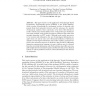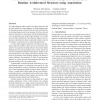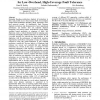632 search results - page 119 / 127 » Explicit Substitutions and Programming Languages |
PKDD
1999
Springer
13 years 11 months ago
1999
Springer
This paper reports on the application of the Strongly Typed Evolutionary Programming System
STEPS
to the PTE2 challenge, which consists of predicting the carcinogenic activity of...
CODES
2007
IEEE
13 years 11 months ago
2007
IEEE
Today's MPSoC synthesis and exploration design flows start abstract input specification model captured in a system level design language. Usually this model is created from a...
I3E
2003
13 years 8 months ago
2003
: E-applications are increasingly being composed from individual services that can be realized with different technologies, such as, e.g., Web Services and standard component techn...
OOPSLA
2009
Springer
14 years 2 months ago
2009
Springer
An object diagram makes explicit the object structures that are only implicit in a class diagram. An object diagram may be missing and must extracted from the code. Alternatively,...
ASPLOS
2006
ACM
14 years 1 months ago
2006
ACM
Redundant threading architectures duplicate all instructions to detect and possibly recover from transient faults. Several lighter weight Partial Redundant Threading (PRT) archite...



